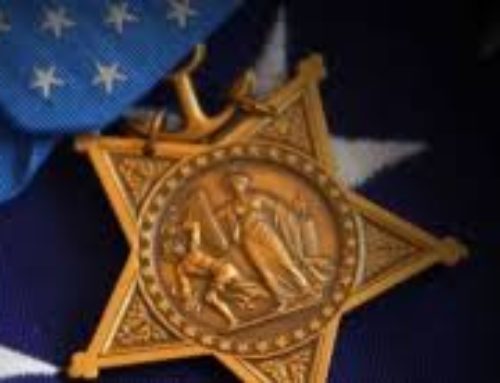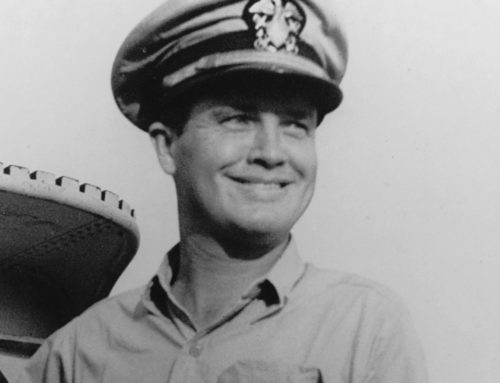Samuel Dealey was born on September 13, 1906, in Dallas Texas, to a prominent Texas family. Indeed, his uncle was the founder and publisher of the Dallas Morning News. After graduation, as expected, young Samuel was appointed to the United States Naval Academy. However, after posting poor grades, Dealey “bilged out” of the Academy. (According to tradition, midshipmen never walk out the “bilger’s gate” – a pedestrian gate in the Naval Academy’s outer stone wall. However, those who flunked out of the Academy exited through the bilge gate, leading to the term “bilge out.”) Amazingly, Dealey won reinstatement, eventually graduating from the Academy in 1930.
After finishing his stint at Submarine School, Dealey served aboard a number of submarines, including USS S-34, USS S-24, USS Nautilus, as well as the S-20, a non-combat at-sea experiment submarine. After World War II broke out, Dealey was assigned to the USS Harder (SS-257), a new commission, in December 1942. Not quite a year later, Harder survived a “Blue-on-Blue” (friendly/inadvertent fire on friendly forces.) Would this be a foreshadowing of Dealey’s and the Harder’s fortune?
In June of 1943, Harder was sent on her first war patrol to South Honshu. During the first attack, Harder was made to dive deep by an aggressive attack by a Japanese escort. As a result, Harder crashed in to the muddy bottom – not a great way to start its patrol. Two nights after backing Harder out of her predicament, Dealey had his first real success by torpedoing the Sagara Maru, causing her to beach on the Japanese mainland. For the next four days, Dealey and Harder’s crew made seven attacks on three separate convoys.
After returning to Midway for repairs to a troublesome diesel engine, Harder returned to sea for her second war patrol near Honshu. Over the next fourteen days, Dealey made nine attacks, of which five ships were taken down.
At the end of October 1943, COMSUBPAC VADM Charles Lockwood sent the Harder, USS Snook (SS-279), and the USS Pargo (SS-264) to the Marianas to collectively attack Japanese shipping, in preparation for the invasion of Tarawa which would occur in late November. Due to ongoing communication issues, Harder was separated from Pargo during a coordinated attack, leaving Dealey to operate alone. On 19 November Dealey picked up a convoy of three large Japanese freighters and their escorts, north of the Marianas. Positioned for attack, Harder fired ten torpedoes in its first attack, hitting two targets. Later that evening, Dealey fired eleven more torpedoes at a fleeing freighter, hitting it twice. Dealey and the Harder headed back to Pearl Harbor after being driven off by gun fire from the Japanese crew aboard the still afloat freighter. (It was later determined that all three ships were sunk, for a total of four ships during Harder’s third patrol.)
Harder, still experiencing issues with her engine, was refit with four new engines during her stay in Pearl Harbor. When the work was completed, she was sent out on her fourth patrol, accompanied by the USS Seahorse (SS-304). Assigned to “lifeguard duty” (coming to the aid of downed aviators), Harder was sent to rescue an injured pilot on a small, enemy-held island west of Woleai. Under protection of friendly air cover, Dealey steered Harder toward the beach, grounding the bow at a nearby reef. A rubber boat was sent out amid Japanese sniper fire to rescue the pilot, ENS John Galvin. Miraculously, Galvin and his rescuers all returned unharmed.
Dealey continued his barrage, scoring his next four hits on a Japanese destroyer. Upon sinking the destroyer IJS Ikazuchi, he sent the message, “Expended four torpedoes and one Jap destroyer.” Merely four days later, near Woleai, Dealey would sink the Matsue Maru, only to then surface again and take out a Japanese garrison with Harder’s 4-inch deck gun. This victory would end Harder’s 4th war patrol.
Harder’s fifth war patrol would prove to be as successful as its previous four patrols. Dealey would get his second destroyer with the sinking of the IJS Minatsuki, in the Sibutu Passage, earning him the nickname “Destroyer Killer”.
After five successful war patrols, RADM Ralph Christie believed that the time had come for Dealey to relinquish command of Harder. Dealey was reluctant to turnover with more than 1/3 of his current being transferred. He felt strongly that he should break in the new crew before turning Harder over to its new command. RADM Christie reluctantly agreed to Dealey’s sixth and final war patrol. So, after a brief two week break, Harder, under Dealey’s command, left Freemantle on 5 August as part of a “Wolf pack” including the USS Haddo (SS-255) and Uss Hake (SS-256). Their job was to destroy the Japanese shipping corridor off the Philippines west coast.
Harder and Haddo joined three other submarines who were waiting for a Japanese convoy in Paluan Bay. As the convoy sailed out of the Bay, the subs attacked, resulting in four sunken merchant ships, none of which could be attributed to Dealey and the Harder. The Harder and Haddo next moved to Manila Bay. Here they picked up three frigates, which they promptly sunk, earning Dealey two more victories.
Harder and Haddo moved to rendezvous with the Hake. Having expended its last torpedo on the destroyer Asakaze, Haddo left to replenish its weaponry. Believing that the Asakaze was merely damaged and towed to a nearby port, Harder and Hake quietly waited outside the bay. On the morning of 24 August, a mindsweeper and the destroyer, Phra Ruang, left the protection of the Bay. The Hake moved to attack the destroyer, but fell back when the destroyer returned to the bay. The mindsweeper had continued out, constantly pinging for hidden submarines in the area. Hake’s commanding officer, Frank Haylor, recalled seeing Harder’s periscope at 0647. He then heard a barrage of depth charge explosions at 0728. For the next two weeks Haylor and the Hake searched for any sign of the Harder. After news that oil, woodchips, and cork had been found in the vicinity, it became apparent that Harder, along with Dealey and his brave crew, had been lost.
All told, CDR Dealey and the Harder sank an astonishing 18 enemy ships, putting him among the top five US Submarine skippers in World War II. CDR Dealey was posthumously awarded the Medal of Honor in 1945.
Information from Submarine Hero – Commander Samuel Dealey, by Dr. Edward C. Whitman.


